Pepper Dulse – Edibility, Identification, Distribution
Osmundea pinnatifida
There are several other similar, though less widely distributed Osmundea species, referred to generally “flat fern weeds”, including: Royal Fern Weed (O. osmunda), Brittle Fern Weed (O. oederi), and Iridescent Fern Weed (O. truncata). All are edible and delicious in similar ways to pepper dulse, and are most easily distinguished by their habitats (see below).
Related pages:
- Introduction to Seaweed Foraging
- Edible Seaweed Guide
- Seaweed Webinar (includes an in depth film on pepper dulse)
“The webinar was amazing! You are a good storyteller. Scientific information, combined with tips and beautiful picturing. 👏” – Kanlenaki on Instagram
“This was absolutely brilliant, thank you so very much for being so generous with your knowledge! The webinar format of videos and live worked fantastically!” – Sarah Hobbs, Webinar chat comments
- Identification – 3/5 – Quite distinctive when you tune in to it, though novices may confuse it with other small brown seaweeds like caragheen. Look for small (1-8cm) flattened fronds, irregularly branched, though usually roughly pyramidal in outline at the tips. The colour can vary according to where and when it is growing, from yellowish-green (higher up the shore, in summer) to deep chocolate brown (lower down, winter). See notes on closely related flat fern weeds below. The taste of all flat fern weeds is very distinctive and as no seaweeds growing in inshore tidal zones are toxic, this is a good way to confirm that you have one of them. Occasionally people mistake wrack siphon weed (Vertebrata lanosa) for pepper dulse. It shares some of pepper dulse’s truffly properties, but has an unpleasant gritty texture, and is only found attached to other seaweeds (usually egg wrack). Wrack siphon weed (I call it mermaid’s pubes, though you will occasionally see it more politely listed as sea truffle) has delicious truffle properties once you overcome it’s challenging texture. Dried and powdered it tastes like truffly curried cauliflower. See my post on wracks for more on wrack siphon weed.
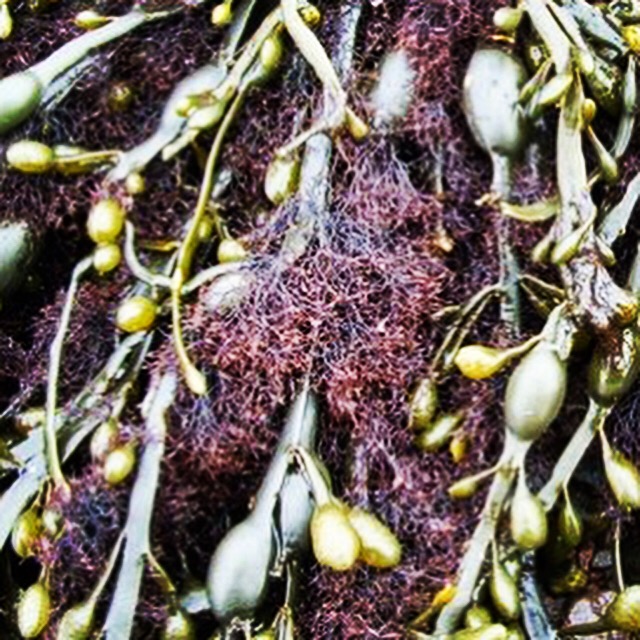
Wrack siphon Weed (shown here) only grows epiphyticly, usually on wracks, most often egg wrack. Pepper Dulse only grows on rocks.
- Edibility – 5 /5– Pepper dulse is a true gastronomic gem. Surprising, intense, mineral, aromatic, peppery, garlicy, powerful umami. Variously described as “The Truffle of the Sea”, as a cross between truffle and lobster and (by me!), “chef crack”. The flavour , while always extraordinary, can be more or less intense according to which Osmundea species you have, exposure and stage of growth.
- Habitat and other flat fern weed species – Clinging to rock from mid tidal range downwards. The different flat fern weeds mentioned above have the following preferences: Pepper dulse – open rock surfaces on mid and lower shore. Royal and brittle fern weed ply their trade somewhat lower, or in non-draining rock pools. Brittle fern weed is epiphytic, usually on wracks. Royal fern weed grows up to 20cm and has a preference for more exposed coast.
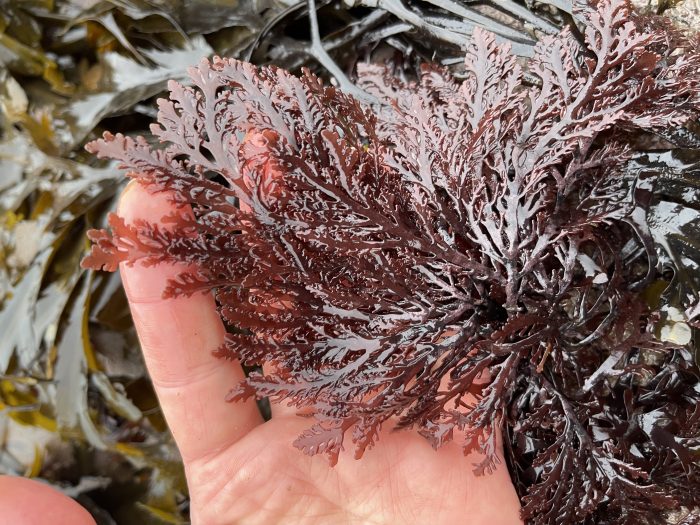
Royal fern weed, Osmundea osmunda, grows further down the tidal range than pepper dulse and can be distinguished by larger size (up to 20cm fronds), flat profile, redder colour and rosette growth habit. It can be used in the same way as pepper dulse. Image ©Galloway Wild Foods
- Distribution – 5/5 – Very common in suitable habitats within its tidal range. Best picked, as with most seaweeds, where it is washed by strong currents, but not smashed by big waves!
- Season – All year round in exposed locations, but at its best December-May
- How to harvest – trim from the rocks with scissors. DO NOT PULL as this will bring crumbs of rock and barnacle with it, as well as undermining future growth. Don’t clear whole areas – spread your picking around.
- How to eat: Fresh and raw (ideally with the waves crashing at your feet), or dried as a rich, spicy, aromatic seasoning. Fresh pepper dulse deteriorates quickly, keeping in the fridge for a maximum 5 days. Avoid crushing it as this further reduces its fridge life. It can be pickled, but only use cold vinegar, never hot, as this immediately breaks it down and unleashes its volatile compounds into the air. A friend of mine who was experimenting with it poured boiling water over a load. The vapour that came off it he described as “somewhere between raw onions, pepper spray and mustard gas!” (he survived, but was crying and struggled to breathe for a few minutes). Even cold pickled, pepper dulse will become sludgy in a week or two – though it is the best tasting sludge ever. My tastiest ever pickle combined sea lettuce, dried pepper dulse and dried cep – the most umami-rich pickle i’ve ever tasted.
This amazing little seaweed packs an extraordinary flavour that you really have to taste to believe. I’ve fed it fresh to food lovers who reacted with such amazement, delight and determination to have more, that I expect they are now to be found living in coastal caves as ragged pepper dulse junky hermits, venturing out twice a day to gnaw it fresh from the rocks…
One of my very favourite foraging experiences is gathering and eating pepper dulse on the shore, with the waves breaking about my feet. For me, the flavour is deeply elemental – of rock, sea and brimstone. If you inadvertently pull it from the rocks (rather than trimming with scissors as it should be done), it brings with it some of the rock and barnacle to which it clings. I think this close integration with its rock home that gives it its intense minerality. Seaweed forager extraordinaire, Rory “Fresh From The Sea” MacPhee (to whom I am hugely indebted for introducing me to this delight) believes pepper dulse to live in close and complex mutualism with smaller marine algae and shellfish.
More scientifically, much of the flavour may be due to the presence of terpenoids, a class of strong-smelling organic compounds that are also found in conifer resin and many essential oils. These, and the other pungent compounds that give pepper dulse its extraordinary taste are believed to have evolved to deter some aquatic grazing organisms. There is little published research into the nutritional profile of pepper dulse, but my instinct tells me that, while it may contain many of the beneficial minerals and proteins of other seaweeds, it shouldn’t be eaten in large quantities. This is unlikely to be an issue, as the flavour is so intense, you’ll never need much. Unless you become a certified peppy-D junky like me and over-graze it!
It is possible to buy pepper dulse from commercial harvesters and processors in dried form. This is still a magnificent ingredient that can be used in place of salt, pepper and various spices in many savoury dishes. But really, its but a shadow of its fresh self. Having a fridge-life of about 2 days, I doubt you’ll ever be able to buy it fresh. The purest gastronomy is in tasting this seaweed free, among the rock and foam of its elemental home. Why pay infinitely over the odds for less than half the pleasure…?
Apart from just nibbling it fresh, I like to add the fronds to wild sushi and sashimi, or lay them on pieces of smoked egg. Coat the rim of a glass with it in dried, powdered form to make a filthy dirty martini (add a spiral wrack caper instead of a salty olive), or sprinkle it on soft boiled eggs. As a spice, the only limits are your imagination – but as is so often the case with wild foods, keeping it simple often works best – sprinkle it on fish or (even better) shellfish before grilling. See and listen to my exploration of our native spice rack here.
Related pages:
- Edible seaweed guide
- Introduction to foraging for seaweeds
- Recipe: Scottish dashi broth
- Recipe: How to make sushi with wild ingredients
- Wild Food Guide
- 10 wild foods in season now
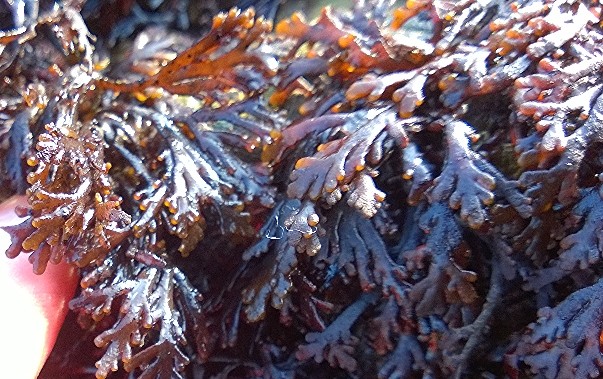
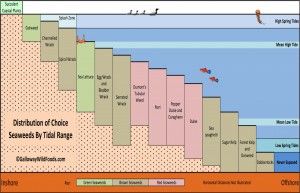

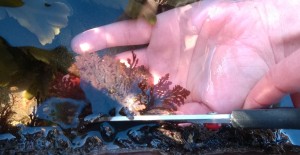
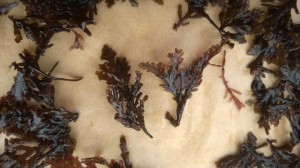
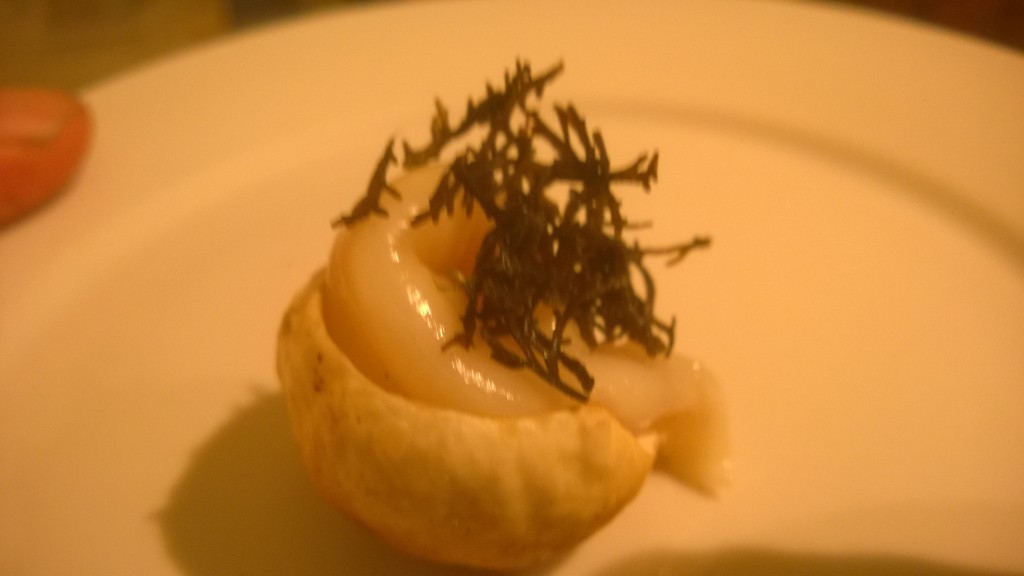
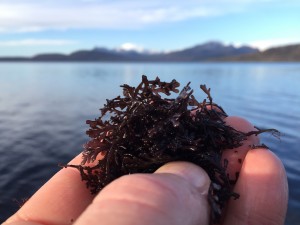
18 Comments
Hi Mark!!!
You gave me & my husband Mark a brilliant wild foods tour in July (at Glenapp) when we were on honeymoon. I’ve since launched my spice business and am currently working on a blend with dulse! I’m not sure it’s the pepper dulse you write of here, but it’s from Maine & tastes delightful. My blend incorporates dried mushroom and nettles, among other things. Going fora deeply umami spice blend for soups and fish and the like. Anyway, I think I’m also becoming a Dulse junky! Cheers, Claire
Great stuff Claire. I make a lot of fungi/seaweed stock powders – they are highly synergistic. Cheers, Mark.
Hello Mark, this post was great! Thanks for the inspiration! Please let me know how do you prepare a stock powder. I do dry pepper dulse by myself and I would like to have any idea how to toast it or to smoke it. I use pepper dulse stock almost for everything!
Hi Bela, I just dehydrate it then powder it. On its own it works as peppery seasoning. Mixed with laver or dulse powder it becomes a more rounded stock. Cheers, Mark
when i was lil my dad used to bring (peeper dulce) in lil paper bags from the glasgow barras, was amazing!
i got 2 q’s if you got time?
1, do you sell it?
2, do you do foraging courses?
many thanks for your time and i LOVED the junky/cave gag, be safe, jim
Hi James,
No, I don’t sell any wild food, only teach.
Yes, I do foraging walks/workshops/courses – see my events calendar: http://www.gallowaywildfoods.com/learn-to-forage/foraging-events-calendar/
I’m currently taking a break from public events (Nov 2016 – March 2017), but still available for private bookings: http://www.gallowaywildfoods.com/learn-to-forage/about/
Hope to see you some time!
Cheers,
Mark.
Just been back out to where you took us in March to forage for seaweed at Gress, Isle of Lewis. We went prepared with waders and dry suit to wade out to the rocky area and successfully gathered sugar kelp and (I think) pepper Dulse, as well as sea lettuce. Now need to dry the fruits of our labour to last until next Spring! Many thanks for your guidance and inspiration! We couldn’t find any sand clams or spoots, though, are they seasonal?
I laughed all the way through your wonderful descriptions. I have discovered this amazing little seaweed in Cornwall and am definitely becoming one of your pepper dulse junkies … threatening to take up residence in a cave any minute, much to my husband’s dismay. Am about to buy some fresh crab this morning and will be foraging later … but just where is my little secret.
Hello!!
thanks for your article and your website generally its a fantastic resource to the keen forager. i have just had a great evening up to my knees in spring water feasting on pepper dilisk and sea spagetti in the glorious sunshine. epic. i came home and have been drying the pepper dilisk in the oven… wow, my eyes are burning to the extent that i cant actually sleep now. it is very potent stuff indeed. has anyone else experienced this ??
Bobby
Hi Booby,
I’m glad you are finding the website useful.
Yes, when exposed to heat, i’ve heard of people getting “pepper spray” experiences! Potent stuff indeed. I generally try to dry it at as lower temperature as possible to avoid this (loss of flavour?), berhaps drying it at a higher temperatures creates a whole new treat..?
Cheers,
Mark.
Dear Mark,
Could we pls ask you assistance to obtain a 100g sample of the Pepper Dulse Seaweed. Would a specification be availble? Is it available as a powder?
We would like to look at the Pepper Dulse Seaweed in our flavour creations work in Australia.
Many Thanks
Bruno Briedis
Hi Bruno, Sorry, but I don’t supply wild foods – I only teach about them. Mark
Dear Mark,
Could we pls ask you assistance to obtain a 100g sample of the Pepper Dulse Seaweed. Would a specification be availble? Is it available as a powder?
We would like to look at the Pepper Dulse Seaweed in our flavour creations work in Australia.
Many Thanks
Bruno Briedis
Site Purchasing Manager RM FL
Phone: +61298274030, Mobile:+61420305617
Givaudan Australia Pty Ltd, 12 Britton St, Smithfield, NSW, 2164, Australia
engage your senses: http://www.givaudan.com
Dear Mark,
Can you pls advise on procedure to obtain a 100g sample and specification of the Pepper Dulse Seaweed
Many Thanks
Bruno
Oh dear, oh dear, oh dear. I think I may have ruined pepper dulse for myself for ever. You know that bit where you say you have a feeling one shouldn’t eat too much at once…?
So I read all your seaweed posts, and duly set my alarm to go down to the beach at low spring tide. Found, amongst other delights, much pepper dulse – huzzah! Tried a bit… it was… interesting. Very interesting. And quite exciting. But did I actually like it? Not sure, tried a bit more. And a bit more…
After about 8 little tasters – a frond or two each – while I carefully snipped supplies from various rocks, I went home with a strange sense of the flavour imbuing me, like I was a stock it was seasoning or something. Weird.
Then I had a slight tummy ache all evening, and couldn’t get the taste out of my head – or bring myself to eat any dinner: appetite was zero-to-minus. Went to bed, dreamt of teeny seaweed fronds.
The next day, the smell of the pepper dulse I’d left drying had filled the kitchen and made me feel sick. I removed it to a spare room, but was driven mad by the smell of it at my desk – I found a single tiny frond on the floor which was also removed. Now I’m not sure I’ll ever be able to face the flavour again 🙁
Moral of the story? Moderation, especially with new and super-tasty things.
you may be allergic to iodine?
Sounds like pepper pulse may not be for you Ginevra! It is pungent. I wonder if you eat other seaweeds OK? If so, that would probably rule out iodine allergy, but there are plenty of other compounds in pepper dulse that you might not get on with. The other possibility is, seeing that you posted your comment in September, and assuming that is when you harvested it, that the pepper pulse you harvested was old and out of condition. It peaks near me around April/May, and becomes sad and unpleasant over the summer. It does stay strong in cooler waters though, so maybe depends where you are.
Mark
Has anyone tried freeze drying it?